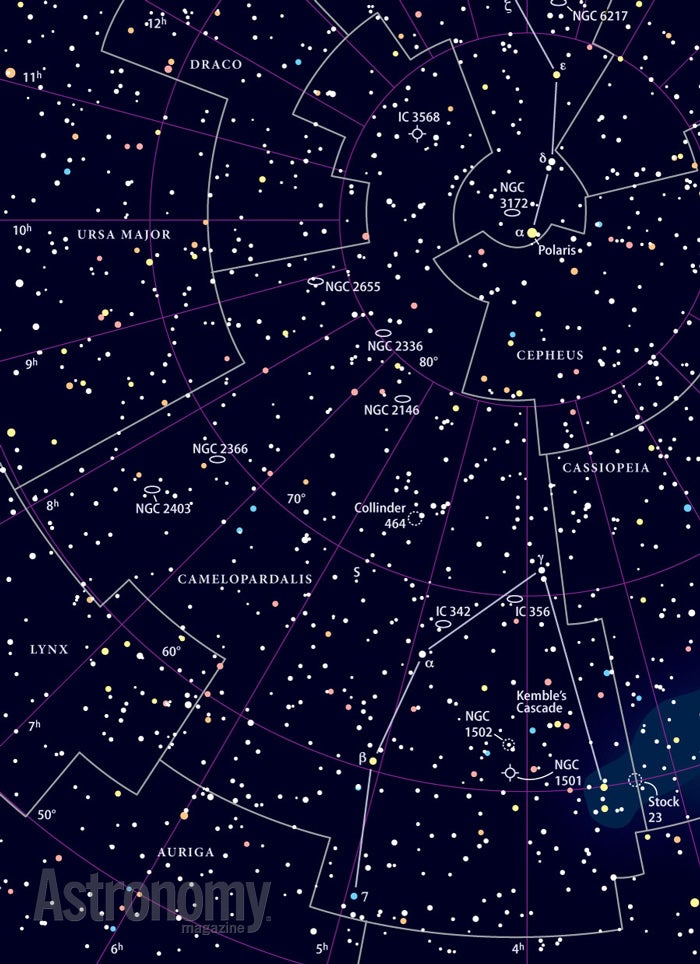
Expand your observing at Astronomy.com
StarDome
Check out Astronomy.com’s interactive StarDome to see an accurate map of your sky. This tool will help you locate this week’s targets.
The Sky this Week
Get a
daily digest of celestial events coming soon to a sky near you.
Observing Talk
After you listen to the podcast and try to find the objects, be sure to share your observing experience with us by leaving a comment at the blog or in the Reader Forums.
Each week, Astronomy magazine Senior Editor Michael E. Bakich, a master at explaining how to observe, posts a podcast about three objects or events you can see in the sky.
Targets for February 13–20, 2014
Small telescope: Double star ADS 5951
Small telescope: Open cluster NGC 2360
Large telescope: Irregular galaxy NGC 2366
Double the fun
This week’s first small-telescope target is the gorgeous double star ADS 5951 in the constellation Canis Major. You’ll find this star 3° east of magnitude 3.0 Omicron2 (ο2) Canis Majoris.
The primary star shines at magnitude 4.8, and the secondary glows at magnitude 6.8.
A 2-magnitude difference means the primary is 6.3 times brighter than the secondary – not a large gap for double stars. The separation between the pair is 26.8″, which lets even a 2-inch telescope split them.
This binary star also exhibits a nice color contrast. The brighter component shines yellow or gold, and the secondary is blue.
This star’s designation – ADS – makes it apparent to astronomers that it is a double star. The label comes from American astronomer Robert Aitken’s massive two-volume New General Catalogue of Double Stars within 120 degrees of the North Pole, published by the Carnegie Institution in 1932. Thus, ADS stands for “Aitken double star.” His catalog contains measurements of 17,180 double stars north of declination –30°.
Cluster in a rich field
This week’s second small-scope object is open cluster NGC 2360, which also lies in Canis Major. British astronomy popularizer Sir Patrick Moore made it number 58 in his Caldwell catalog, a list of 109 deep-sky treats missed by French comet-hunter Charles Messier.
You’ll find this nice cluster 3.3° east of magnitude 4.1 Gamma (γ) Canis Majoris. It shines at magnitude 7.2, which is good because the group sits in a rich star field. It measures 12′ across.
Through a 4-inch telescope at a magnification of 100x, you’ll spot what looks like a stellar bar stretching east to west through the cluster’s center. NGC 2360’s brightest member is magnitude 8.9 SAO 152691, which sits on the eastern end.
Step up to an 8-inch telescope under a dark sky, and the scope will reveal more than 50 stars. Through this aperture scope, the background appears so dense near NGC 2360 that you may have trouble defining where the cluster’s eastern edge ends and the field stars begin.
A worthy deep-sky catch
This week’s large-telescope target is irregular galaxy NGC 2366 in the faint northern constellation Camelopardalis the Giraffe. It glows at magnitude 10.8 and measures 8.2′ by 3.3′. Unfortunately, it resides in a region of sky bereft of bright stars.
Look 3.2° east of the magnitude 5.1 star 43 Camelopardalis, or, if you want to navigate from a brighter star, head 10.6° northwest of magnitude 3.4 Muscida (Omicron Ursae Majoris). Muscida is the star that marks the Great Bear’s nose.
Because of the galaxy’s size – not quite 4 percent as large as the Full Moon – NGC 2366’s surface brightness is low. You’ll need at least a 12-inch telescope under a dark sky to spot anything more than a dull glow. What you can see through smaller scopes is a cloud of ionized hydrogen, called an HII region, that lies off the galaxy’s southwestern edge. You may find this feature cataloged as NGC 2363. That’s an error.
Unlike the galaxy, the nebula has a high surface brightness. Two star clusters supply the energy to make it glow, the more energetic one of which lies embedded in the cloud. If you crank the magnification up to 200x and insert an Oxygen-III filter, the galaxy will disappear, but the HII region will remain bright. Increase the power even more and look for the nebula’s bright center.









